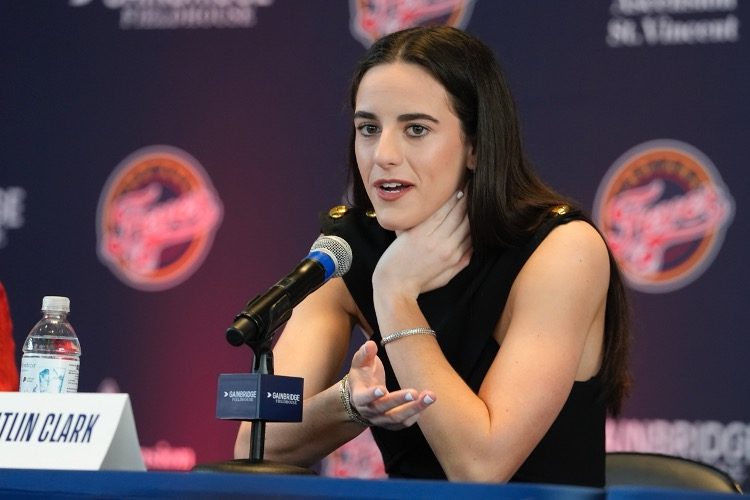
We heard it with the female tennis players. We heard it with our women’s national soccer team (even though they’d lost to 14-year-old boys). Now we hear it with lady basketball sensation Caitlin Clark.
“Look at how much the male players receive,” is the complaint. “She’s not getting the money she deserves!” This is true, too.
Clark is perhaps getting more than she deserves.
(Yes, this will be explained.)
The basketball phenom, who rose to stardom recently owing to her stellar college career with the University of Iowa Hawkeyes, was just recently selected as the WNBA’s number-one draft pick and signed a four-year contract with the Indiana Fever worth $338,056. That amounts to “just” $84,514 per annum. But don’t start crowdfunding for her yet: Word is she’s also signing an eight-year Nike contract that will provide her up to $28 million and her very own shoe. So suffice it to say that she’ll be dribbling, but not drooling from hunger.
But this doesn’t stop media rabble-rousers from rendering economic analyses that are strictly from hunger (there’s an old one for you). A representative example is the following headline from the unreal Daily Reel:
“Outrage Grows Over Gender Pay Gap Between Caitlin Clark’s WNBA Salary and Male NBA Players.”
There’s a reason, however, why the NBA’s yearly salary average of more than $10 million dwarfs the WNBA’s average of just over 100k. It was explained well, too, by a respondent under the Daily Reel piece (it’s so often the case today that a media article’s/video’s best news is in its comments section). As “Christian J” wrote:
Just imagine if people were outraged that Ford is profitable and Dodge is not….
Now imagine that Ford was paying to keep Dodge manufacturing plants open.
Then imagine that people, despite knowing that this is the case, still claimed that it was Ford’s fault….
The NBA is literally paying the bills…
But it’s all the fault of the MEN!
Yes, that’s right. The WNBA only exists because it’s subsidized by the NBA. In fact, the league has not turned a profit anytime during its almost 30-year existence, having lost an average of $10 million annually since its 1996 birth.
So how much should charity-case players in an unprofitable league “earn”? Some might argue that the WNBA players should have to pay to participate; after all, most Americans who want to compete in organized but unmarketable leagues or teams must pay fees to join and fund the endeavor themselves.
In reality, there is unjust discrimination practiced here — on the part of those indignant over the NBA-WNBA pay disparity. After all, do they ever complain about how female fashion models earn considerably more than their male counterparts?
For that matter, we may as well ask why stellar amateur wrestlers or archers don’t earn as much as NBA players, or why phenomenal bricklayers don’t draw the salary neurosurgeons or lawyers do. If some would say I’m comparing different fields (irrelevant, actually), then wonder why heavyweight boxers earn more than lightweights. The answer in every case is: Market forces determine all these pay disparities.
What’s more, if we’re to indulge some arbitrary sense of “fairness,” we should apply it across fields. Is it “fair,” after all, that WNBA players earn more than policemen, whose job is far more important?
Then there’s the elephant in the room. If a lightweight boxer complained that he should receive the same money the heavyweights command, wouldn’t a logical response be: If you want the heavyweights’ purses, fight in the heavyweight ranks?
Likewise, if female athletes want the men’s money, the surefire way to get it is to compete in the men’s arena and succeed. For it’s “Equal pay for equal work,” and the “work” here (aside from pleasing the market) is succeeding among the best competition: the men.
And, anyway, is it reasonable to argue for male-female pay equality within the context of supporting a sex-segregated system that’s inherently unequal?
The intersex performance disparity is great, too. As reflected when the U.S. women’s soccer team — then the world’s best — lost to the FC Dallas Under-15 boys’ squad 5-2 in 2017, there isn’t a physical sport in which the best women could compete in even a robust male high-school environment. Why, in the 400-meter and 800-meter runs, the best times for 14-year-old lads are better than the women’s world records.
Of course, it all does boil down to marketability, and many observers believe that Clark’s stardom will help catapult women’s professional basketball to popularity and profitability. Nike certainly seems to believe in her. But all of this is just theoretical unless and until it becomes reality.
The deeper issue is that too many today have embraced the Marxist idea that pay scales should be determined by some (always arbitrary) conception of fairness. But life is not fair. Is it fair that Stephen Curry was born with the requisite gifts to be a basketball star while some other men are all thumbs? Is it fair that certain people are gifted with genius-level IQs while others muddle along in the warm-summer-day number range?
Then again, will any of these arguments make a difference? We live in a time in which logic is impugned as white, male, and linear. So reason, today, is not very marketable at all.


